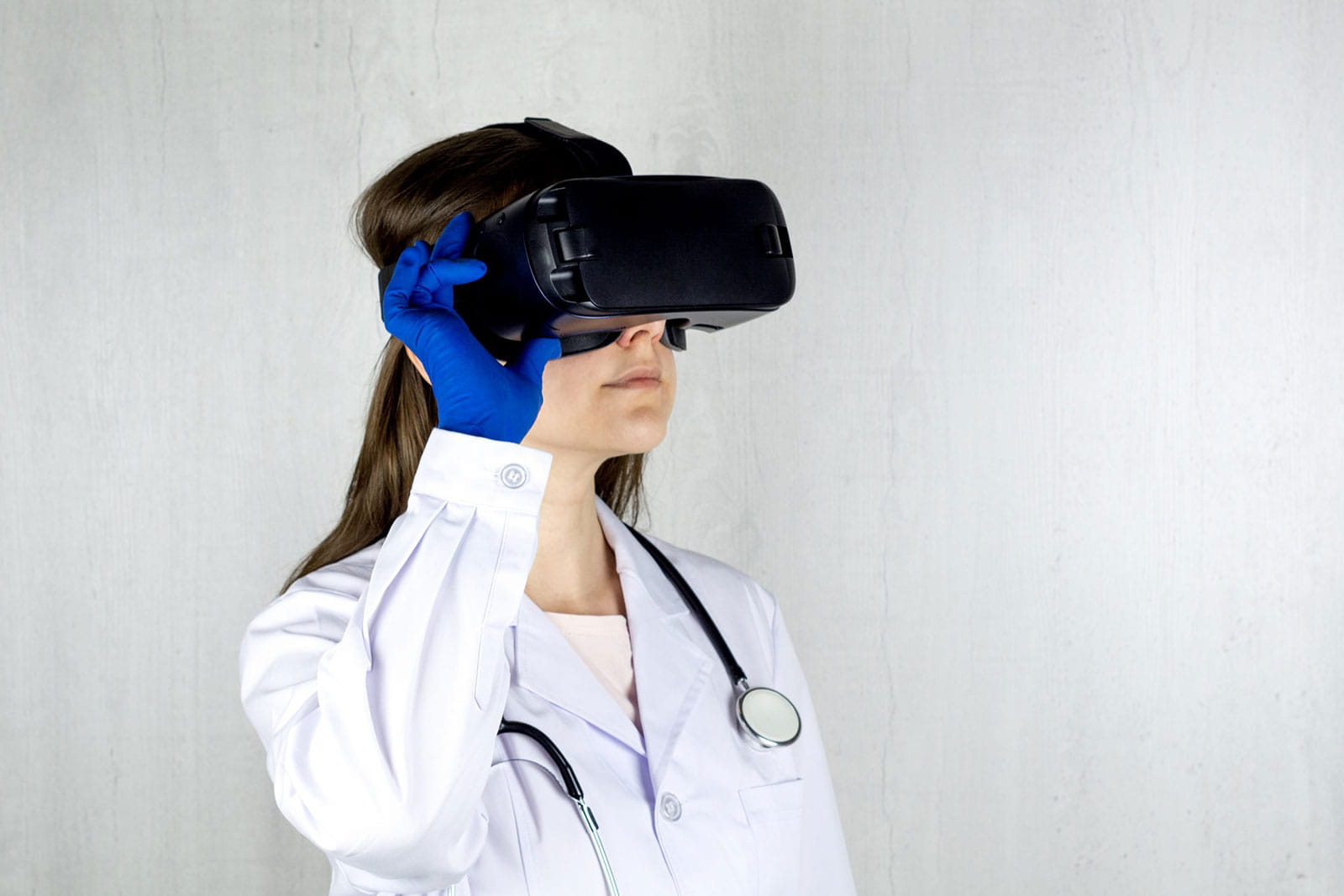Thanks to its immersive potential, it can simulate complex environments and scenarios, facilitating an interactive and engaging learning experience. In this article, we explore the many facets of VR and immersive training, from its pedagogical benefits to its technical challenges, while examining its growing impact in various fields.
I. What is Immersive Training?
Immersive training is based on the use of immersive technologies such as virtual reality (VR) to simulate realistic environments in which learners can interact, practice and learn. Unlike traditional methods, which can lack engagement and real-life practice, virtual reality literally immerses learners in a realistic context where they can act, react and repeat gestures and procedures. In this way, VR transforms the learning process by offering total immersion where the learner becomes an actor.
For more details on immersive learning, read this article!
1.1 Virtual Reality as a central tool
Virtual reality is at the heart of immersive training. By wearing a VR headset and using controllers or sensors, users are immersed in a 3D environment where they can interact in real time. This experience is not limited to simple visualisation. Thanks to visual, auditory and sometimes even tactile stimulation, learners perceive and interact with the virtual environment as if they were in the real world.

1.2Virtual Reality for Professional Training
Immersive training has come a long way thanks to the integration of virtual reality. By providing realistic simulated environments, VR offers learners the opportunity to develop practical skills in authentic situations without the risks associated with the real world. Whether in medicine, security or crisis management, VR simulations enable knowledge to be put directly into practice.
High-risk industries such as construction and aviation benefit particularly from these secure environments. For example, pilots can practise managing emergency situations in a virtual flight simulator without risking their lives or those of their passengers. Technicians and engineers can also follow immersive training courses to learn how to handle expensive equipment in safe conditions before going into the field.
The benefits of immersive training
- Reduced costs associated with training in real conditions.
- Reduced risks for participants.
- Scenarios can be repeated endlessly to reinforce skills.
- Gamification makes learning more attractive.
The challenges
- High initial investment in VR devices.
- Uneven access to this technology, depending on the institution and the company.
II. Immersion at the heart of learning
One of the great strengths of VR is its ability to immerse users in highly interactive virtual environments. This aspect is particularly relevant in the field of education. By immersing students in realistic, hands-on learning scenarios, VR stimulates not only engagement, but also retention of information. In other words, students don't just read or listen to information: they experience the concepts directly.
For example, a history student might be transported to ancient Rome, exploring the city as if it existed today. Similarly, medical students can perform complex surgical procedures in an environment where every detail is faithfully reproduced. This type of immersive training reinforces understanding and improves learners' ability to apply theoretical concepts in real-life contexts.
VR allows :
- Direct interaction with educational content.
- 360-degree exploration of complex concepts, promoting greater understanding.
- The possibility of experiencing past or fictional events in real time.
However, to fully exploit the benefits of VR in education, rigorous pedagogical design is required. It is crucial not to simply reproduce traditional learning methods in a virtual environment. Instead, trainers need to adopt new approaches that exploit the unique possibilities of VR.

III. VR: An Inclusive Tool for Special Education
VR has also shown interesting potential in the field of special education. It can fill certain gaps in accessibility, particularly for pupils with special needs. For example, VR enables students with reduced mobility to explore places that are inaccessible in physical reality. It can also adapt sensory stimuli to meet the specific needs of students with sensory processing disorders.
This immersive technology thus offers opportunities for students who have often been excluded from traditional teaching methods. By creating more inclusive learning environments, VR can not only improve participation, but also enable skills to be developed more equitably.
Examples of use in special education:
Creating sensory simulations adapted for students with hearing or visual impairments.
Using VR to teach social and emotional skills to students with autism spectrum disorders.
IV. The use of Cognitive Bias in Virtual Reality
The question of the fidelity of virtual experiences to reality remains a central issue in the development of VR. To make these experiences more realistic and immersive, VR sometimes uses cognitive biases. Cognitive biases are systematic errors in the way our brains process information, thus influencing our perceptions.

In virtual reality, cognitive biases are used to trick the user's brain into believing that what they are experiencing is real. For example, during a VR experience simulating a situation of vertigo, some users may feel real sensations of vertigo, even though they know they are in a safe virtual environment. This is due to the brain misinterpreting visual information and reacting as if the user were at a height.
Using these biases in the design of virtual environments can therefore intensify immersion and enhance the user experience.
Application examples:
- Stone-cutting simulations in VR, using sounds and vibrations to reproduce the sensation of physical work.
- Experiments where sensory perception, such as balance, is manipulated to increase realism.
V. Virtual Reality and the Transformation of the Role of Trainers
The introduction of VR into education is not only having an impact on learning methods, but is also redefining the role of trainers. In immersive training, trainers are no longer simply transmitters of information. They become experience facilitators, helping learners to navigate and interact in complex virtual worlds.
This evolution requires trainers to acquire new skills, particularly in facilitation, experience design and coaching. They also need to be able to incorporate gamification elements, use analysis tools to customise the monitoring of learner performance, and understand the technical aspects of VR.
Key skills for trainers in a VR environment :
- Technical expertise (handling VR software, troubleshooting).
- Immersive instructional design skills.
- Dynamic group management in virtual environments.
- Adapting teaching methods to suit the diversity of learners.
VI. Virtual Reality and Academic Assessment
In addition to learning, VR also offers opportunities to rethink academic assessment. Unlike traditional assessment methods that rely on written exams or multiple-choice questions, VR allows students to be assessed in realistic scenarios, where they can demonstrate their practical skills and ability to solve problems in real-life situations.

Immersive technologies allow teachers to create more authentic assessments. For example, a medical student can demonstrate their clinical skills by performing a virtual surgical operation, while a crisis management learner can be confronted with a disaster simulation to test their decision-making skills under pressure.
6.1 The challenges of implementing Virtual Reality
Despite its promising benefits, implementing VR in education is not without its challenges. The first obstacle is the cost of the technology. The equipment needed for virtual reality, such as VR headsets and high-performance computers, can represent a significant investment for schools and institutions. This is less and less true today. The improved performance of stand-alone headsets now makes them a reliable option that is more accessible and easier to deploy.
The choice of tools is essential if immersive training is to be easily adopted by both users and trainers. Adopting the right tool is essential. To do this, it is important to determine what is best for you:
Find out more about how to overcome the obstacles to integrating immersive technologies here!
Conclusion
Virtual reality is emerging as a revolutionary technology in education and vocational training, providing innovative solutions for learning and assessment. Its ability to create immersive environments, personalise learning experiences and overcome the limitations of traditional teaching makes it an essential tool for the future. However, for VR to reach its full potential, the challenges of cost and accessibility need to be overcome. With continued investment in technology and appropriate training for educators, virtual reality will continue to transform the educational landscape, paving the way for more interactive, inclusive and effective learning.



